|
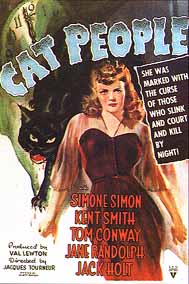 The origin of the startle effect is recognized
as 1941, in the famous bus scene from Val Lewton and Jacques
Tourneur’s B-movie surprise success, Cat People,
where Alice (Jane Randolph), being followed by something from
screen left, is surprised by a bus barreling in from screen
right. Dennis Fischer offers a typical analysis of Cat
People’s startle effect: "This type of scene with a
slow buildup and sudden release became known as a
‘bus,’ and was a component in many horror films
thereafter. The idea was to get the audience to expect something
and then catch them totally off guard from another
direction."1 According to Edmund G.
Bansak, Lewton apparently got feedback from his first bus effect
in Cat People: "When Lewton attended a sneak preview
audience for the film, he sat in the back and witnessed an entire
audience jumping in unison at the appropriate time."2 After that sensational success, Lewton included and
modified startle effects in all nine of his horror films,
regardless of who was in the director’s chair: Jacques
Tourneur, Mark Robson, Robert Wise. The origin of the startle effect is recognized
as 1941, in the famous bus scene from Val Lewton and Jacques
Tourneur’s B-movie surprise success, Cat People,
where Alice (Jane Randolph), being followed by something from
screen left, is surprised by a bus barreling in from screen
right. Dennis Fischer offers a typical analysis of Cat
People’s startle effect: "This type of scene with a
slow buildup and sudden release became known as a
‘bus,’ and was a component in many horror films
thereafter. The idea was to get the audience to expect something
and then catch them totally off guard from another
direction."1 According to Edmund G.
Bansak, Lewton apparently got feedback from his first bus effect
in Cat People: "When Lewton attended a sneak preview
audience for the film, he sat in the back and witnessed an entire
audience jumping in unison at the appropriate time."2 After that sensational success, Lewton included and
modified startle effects in all nine of his horror films,
regardless of who was in the director’s chair: Jacques
Tourneur, Mark Robson, Robert Wise.
Maligned as mindless and a hallmark of B-movies
and exploitation fare, the film-based startle effect can be found
in all manner of horror and thriller films: from blockbusters
like Rosemary’s Baby (1968), The Exorcist (1973),
Jaws (1975), Jurassic Park (1994), and Independence Day
(1996), to contemporary thrillers like Jennifer 8 (1992), The
Client (1994) and Blink (1994). The effect can also
work on the television screen, in made-for-television films such
as Salem’s Lot (1979), and in series such as The
Night Stalker (ABC 1974-75), Tales From the Crypt (HBO
1980-), and The X-Files (Fox 1993-). The critical contempt
and scholarly neglect of startle has hidden something potentially
profound. A bus arrives in Cat People and viewers are
startled; a bus arrives in The Graduate and viewers smile.
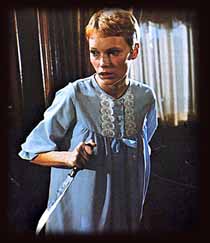 Strangely, while viewers can experience
surprise while watching everything from melodramas to
documentaries, startle occurs much more frequently, if not
solely, in horror and thriller films--specifically, startle
occurs while viewers are following what I call threat scenes.
These are scenes where viewers follow a character under threat by
an offscreen menace. Any number of Hollywood genres present
sudden sound modulations and rapid visual movements as dramatic
and sensational as the horror/thriller threat scene: exploding
F-16s, Uzi shoot-outs, backdraft explosions, and choreographed
ballets of bullets and bombings. But startles in these contexts
are far less common. Strangely, while viewers can experience
surprise while watching everything from melodramas to
documentaries, startle occurs much more frequently, if not
solely, in horror and thriller films--specifically, startle
occurs while viewers are following what I call threat scenes.
These are scenes where viewers follow a character under threat by
an offscreen menace. Any number of Hollywood genres present
sudden sound modulations and rapid visual movements as dramatic
and sensational as the horror/thriller threat scene: exploding
F-16s, Uzi shoot-outs, backdraft explosions, and choreographed
ballets of bullets and bombings. But startles in these contexts
are far less common.
We are left to conclude that it is the threat
scene and its ability to establish a dreadful space, a fearful
anticipation of the unknown, which somehow primes the startle
mechanism. It has long been known that there are two ways to
trigger a startle response: "one, through surprise, or a
sudden, unexpected stimulus; the other, by mere intensity or
amount of stimulus." Yet, film-based startles are not solely
dependent on sudden shifts in light or sound, or else music
videos would trigger dozens. Unlike the knee-jerk, the sneeze, or
the flinch, startle reflexes are modified by emotional and
cognitive states.
Recent Experimental Findings in Startle
The last ten years has seen a resurgence of
experimental work with the human startle response. Many studies
now support the finding that "the vigor of the startle
reflex varies systematically with an organism’s emotional
state . . . [specifically] . . . the startle response (an
aversive reflex) is enhanced during a fear state and is
diminished in a pleasant emotional context."3 Researchers have come to this conclusion after showing
subjects slides previously classified as pleasant, neutral, and
unpleasant,
pictures of violent death, snakes,
bloody wounds or burns, disasters, aimed guns, medical
injection, and angry, destitute, or starving people;
neutral slides were generally common household objects,
such as a hairdryer, a book, and shoes; positively valent
pictures included opposite-sex nudes, romantic couples,
babies, cuddly animals, sports scenes, and appetizing
food. ("EASR," p. 382)4
Subjects are startled with sound and light
bursts while viewing images from each of the three categories.
Amazingly, the startle is not only strongest to negative images,
but also weakest to positive images, with neutral images falling
between negative and positive, a correlation that is
"independent of measures of orienting, arousal, and interest
in the materials."5
Two researchers in Amsterdam have reproduced
these findings with one-minute video clips of fearful, sexual,
and neutral imagery:
The fearful fragments were climaxes
from horror movies, showing fright and flight behavior,
bloody bodily mutilations, sharp weapons, or frightening
facial expressions. Sexual scenes were derived from
pornographic films specifically designed to appeal to
women (Candida Royalle, Femme Productions, New York) and
showed explicit sexual acts, including sexual
intercourse. Neutral scenes were selections from
travelogues and documentaries and depicted objects and
outdoor scenes with little activity.6
For both men and women, "magnitude of
startle responses was significantly larger during fearful film
fragments than during either sexual or neutral fragments"
("MASR," p. 567).
page 1 of 3

|

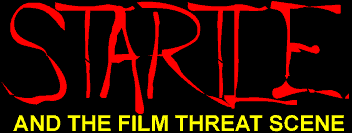
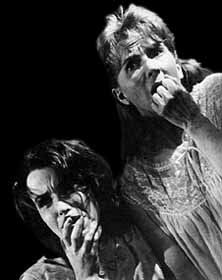 My wife is often startled when the phone rings.
The phone doesn’t bother me or the kids, but all of us have,
at one time or another, found ourselves alone in a room only to
turn and be startled by someone hovering behind us. More
typically, I recently saw a horror film with a friend. He was
startled so frequently and forcefully that I worried he would
pull a muscle. Millions have been startled while watching
threatening film scenes. We can pinpoint the frames in Cat
People where one of film’s first startles—a public
bus of all things—bursts into frame; we can study the exact
moment in Jaws when Hooper, while scuba diving, is
startled by a corpse popping through a shattered boat hull; we
can inspect the infamous startle in Wait Until Dark when
Alan Arkin’s psychotic killer (supposedly incapacitated)
leaps, Olympian-like, after Audrey Hepburn’s blind
housewife. Since the early 40s, films have refined and
increasingly used the startle effect. For instance, 1941’s Cat
People deploys two startle effects, while Paul
Schrader’s 1982 remake offers 8, a typical example of the
hypersensationalization of the post-Psycho horror and
thriller film.
My wife is often startled when the phone rings.
The phone doesn’t bother me or the kids, but all of us have,
at one time or another, found ourselves alone in a room only to
turn and be startled by someone hovering behind us. More
typically, I recently saw a horror film with a friend. He was
startled so frequently and forcefully that I worried he would
pull a muscle. Millions have been startled while watching
threatening film scenes. We can pinpoint the frames in Cat
People where one of film’s first startles—a public
bus of all things—bursts into frame; we can study the exact
moment in Jaws when Hooper, while scuba diving, is
startled by a corpse popping through a shattered boat hull; we
can inspect the infamous startle in Wait Until Dark when
Alan Arkin’s psychotic killer (supposedly incapacitated)
leaps, Olympian-like, after Audrey Hepburn’s blind
housewife. Since the early 40s, films have refined and
increasingly used the startle effect. For instance, 1941’s Cat
People deploys two startle effects, while Paul
Schrader’s 1982 remake offers 8, a typical example of the
hypersensationalization of the post-Psycho horror and
thriller film.

 The origin of the startle effect is recognized
as 1941, in the famous bus scene from Val Lewton and Jacques
Tourneur’s B-movie surprise success, Cat People,
where Alice (Jane Randolph), being followed by something from
screen left, is surprised by a bus barreling in from screen
right. Dennis Fischer offers a typical analysis of Cat
People’s startle effect: "This type of scene with a
slow buildup and sudden release became known as a
‘bus,’ and was a component in many horror films
thereafter. The idea was to get the audience to expect something
and then catch them totally off guard from another
direction."
The origin of the startle effect is recognized
as 1941, in the famous bus scene from Val Lewton and Jacques
Tourneur’s B-movie surprise success, Cat People,
where Alice (Jane Randolph), being followed by something from
screen left, is surprised by a bus barreling in from screen
right. Dennis Fischer offers a typical analysis of Cat
People’s startle effect: "This type of scene with a
slow buildup and sudden release became known as a
‘bus,’ and was a component in many horror films
thereafter. The idea was to get the audience to expect something
and then catch them totally off guard from another
direction."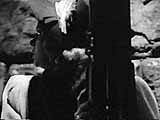 View an animated GIF of the bus scene in Cat People.
View an animated GIF of the bus scene in Cat People. Strangely, while viewers can experience
surprise while watching everything from melodramas to
documentaries, startle occurs much more frequently, if not
solely, in horror and thriller films--specifically, startle
occurs while viewers are following what I call threat scenes.
These are scenes where viewers follow a character under threat by
an offscreen menace. Any number of Hollywood genres present
sudden sound modulations and rapid visual movements as dramatic
and sensational as the horror/thriller threat scene: exploding
F-16s, Uzi shoot-outs, backdraft explosions, and choreographed
ballets of bullets and bombings. But startles in these contexts
are far less common.
Strangely, while viewers can experience
surprise while watching everything from melodramas to
documentaries, startle occurs much more frequently, if not
solely, in horror and thriller films--specifically, startle
occurs while viewers are following what I call threat scenes.
These are scenes where viewers follow a character under threat by
an offscreen menace. Any number of Hollywood genres present
sudden sound modulations and rapid visual movements as dramatic
and sensational as the horror/thriller threat scene: exploding
F-16s, Uzi shoot-outs, backdraft explosions, and choreographed
ballets of bullets and bombings. But startles in these contexts
are far less common.